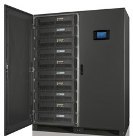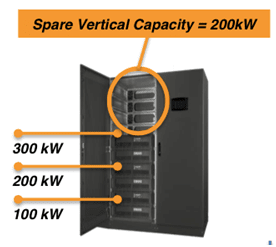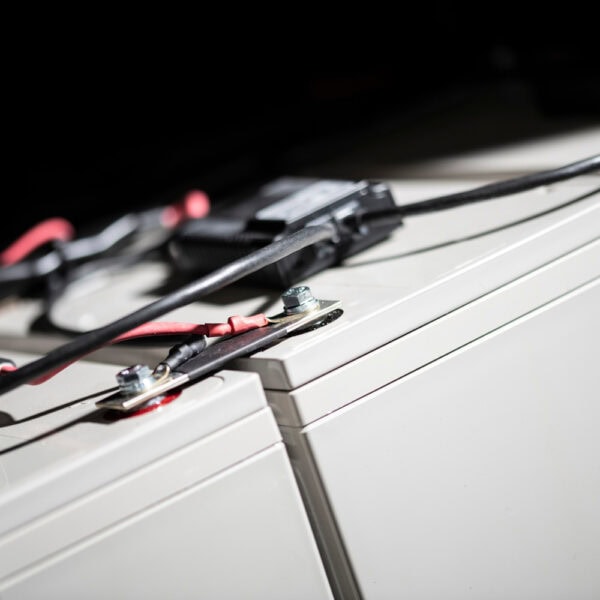Following the last article, where we discussed exactly what UPS systems are (and aren’t), I thought it would be useful to consider some of the different forms these uninterruptible power supplies can take. This is going to be a bit technical at times, but there is a lot of confusion over the different types of UPS power supplies available, and hopefully, I can clear some of that up.
So without further ado…
UPS Systems Sizing
The first thing to consider when weighing up the benefits of different UPS system sizing is; uninterruptible power supplies range from units designed to support a single desktop PC to those built to support data centre infrastructures.
Let me put that in perspective.
A basic desktop PC might run on a 400w power supply, which conservatively would require a 640vA (Volt-Amperes) uninterruptible power supply to allow time for safe shutdown in the event of a power outage.
At the other end of the scale, KUP’s KOHLER PW 9500DPA system can be scaled up to 500kvA (Kilo-volt-amperes) per frame, with the potential for six frames to be combined in parallel. That’s a total of 3MvA (mega-volt-amperes) – Over 4,687 times the output capacity of the uninterruptible power supply from our first example.
In terms of UPS size limits, uninterruptible power supplies can be roughly categorised as follows:
· Micro (Up to 1000vA) – Typically designed as an uninterruptible power supply for PC to accommodate a single desktop.
· Mini (500 – 2000vA) – Suitable for UPS power systems to supply a file server or complete workstation, e.g. a PC and peripherals such as a basic printer.
· Medium (3 – 20kvA) – Sufficient for uninterruptible power supplies to power an office network, small server farm, or similar.
· High-power (30 – 500kvA per frame) – Systems of this size can accommodate UPS power supplies designed for major data centre operations.
Further to the UPS sizing of the output required, it is also vital to consider the voltage required by critical loads. Electricity is invariably provided at either 230 or 240 volts (single-phase), or at 400 and 415 volts (three-phase) – single-phase uninterruptible power supply systems providing for most domestic and small business purposes, and three-phase UPS systems being required for industrial or larger commercial uses.
Your critical loads will require one or the other, so it’s important to know your UPS size limits!
Three UPS Power System Topologies
I want to include a small disclaimer before I get into this: There are more than three types of uninterruptible power supply.
A wide variety of hybrid power systems – mostly falling within the line interactive category mentioned below – have been developed over the years, but have now largely been superseded by modern, online UPS systems.
With this in mind, here are the three primary types of uninterruptible power supply:
Offline UPS Systems – Usually a small unit which maintains UPS battery charge whilst inactive, switching over to a backup battery power supply in the event that mains voltage fails or falls outside a pre-set tolerance.
Inevitably there is a brief load break during this switchover period (around 2-10ms), and consequently, some purists argue that offline UPS systems are really a form of standby power supply rather than a true uninterruptible power supply. This load break also occurs when the system switches back to mains power, so overall power protection is minimal compared to other uninterruptible power supplies.
Offline UPS systems are typically inexpensive, as they are cheap to produce, and are also more efficient than other systems, as much of the uninterruptible power supplies are inactive whilst mains power is within tolerance. These, however, are not suitable for critical loads.
Line Interactive Systems – Similar to offline uninterruptible power supplies, this term describes a variety of hybrid power systems in which a transformer provides voltage regulation during normal mains usage. The most common types of line interactive system include either a buck/boost or Ferro-resonant transformer.
Transformers enable UPS power supplies to maintain a steady output voltage to critical systems – without switching to and from UPS battery power – whilst the mains voltage is within the range of approximately +20% to -30%, resulting in far fewer load breaks and reduced UPS battery wear.
Online UPS Systems – In an online uninterruptible power supply, the UPS battery charger is replaced by a rectifier/charger block, and the system also includes an inverter which constantly provides processed power to its load. During normal operation, mains power is converted from AC to DC by the rectifier in order to charge the UPS battery and is then converted back to AC by an inverter before it reaches the load.
This process is often referred to as ‘double conversion’.
If the mains supply falls outside pre-set parameters (typically +10% to -20%) or fails entirely, the battery begins to discharge, and the load is unaffected.
The important thing to note here is that power always flows through the uninterruptible power supplies– the only difference in the event of a mains power outage is that the battery will discharge – and consequently, there will never be a load break.
The first online uninterruptible power supplies, developed in the 1970s, included an output transformer which stepped-up voltage provided by the inverter to a level compatible with the supported load. These systems were widely produced – particularly at the very top of the output power range.
Advances in the power semiconductor and transistor technology, however, have enabled the development of transformerless UPS systems. Providing all the benefits of an online UPS system, transformerless UPS systems also offer improved efficiency, reduced operating costs, physical size and weight reduction, less noise, enhanced UPS battery life and lower capital costs.
For these reasons, in 1995 KOHLER Uninterruptible Power launched our first three-phase transformerless UPS systems in the UK and Ireland, and these days our uninterruptible power supply product range is exclusively transformerless.
Removing Single Points of Failure
When selecting an uninterruptible power supply, there is one further thing to consider: Standalone, or modular UPS systems?
Standalone systems function exactly as described above – They provide the benefits of modern UPS technology, and several units can be operated in tandem (known as horizontal scaling) to provide for a greater load.
Modular UPS systems perform the same function, but nearly the entire uninterruptible power supply is divided into modules (hardware and software) to minimise single points of failure – If a single UPS module is faulty, that module can be replaced in isolation without even needing to power down the modular UPS system. This is known as a ‘hot-swappable power supply’.
As a result of this, modular UPS systems boast greater availability than their standalone counterparts, as although the mean time between failures is slightly lower, the time taken to fix those failures is vastly reduced. This adds up to a 99.9999% (six nines) availability for modular UPS systems, compared to 99.999% (five nines) for standalone systems.
In addition, modular UPS systems can be scaled both horizontally and vertically, allowing their UPS sizing to be tailored much more accurately to a client’s needs.
The above image shows a KOHLER PW 9500DPA system with three 100kvA modules. As you can see, there is space for 2 further modules within this rack (vertical scaling), and it is also possible to combine six modules in parallel (horizontal scaling). In practice, this makes it possible for the product to accommodate power requirements anywhere between 100kvA and 3MvA (3000kvA) – Something that was practically science fiction in the not too distant past!
With all this said, the choice of modular UPS systems vs. standalone systems will usually come down to the situation at hand – Just like our earlier discussion on emergency lighting protection, it’s very much a case of picking the right tool for the right job. KUP. offers both modular UPS systems and standalone systems in various sizes, and we’ve implemented both for clients in recent years with great success.
At KUP. we aim to provide our customers with an unrivalled single source for all their power protection needs. We offer a wide range of UPS services, from initial site surveys and uninterruptible power supply design to implementation, UPS maintenance and repairs. Want to find out more, or book a free site survey? Get in touch through our contact page or call us on 0800 731 3269.
Follow us on LinkedIn for regular power protection industry articles & company information







